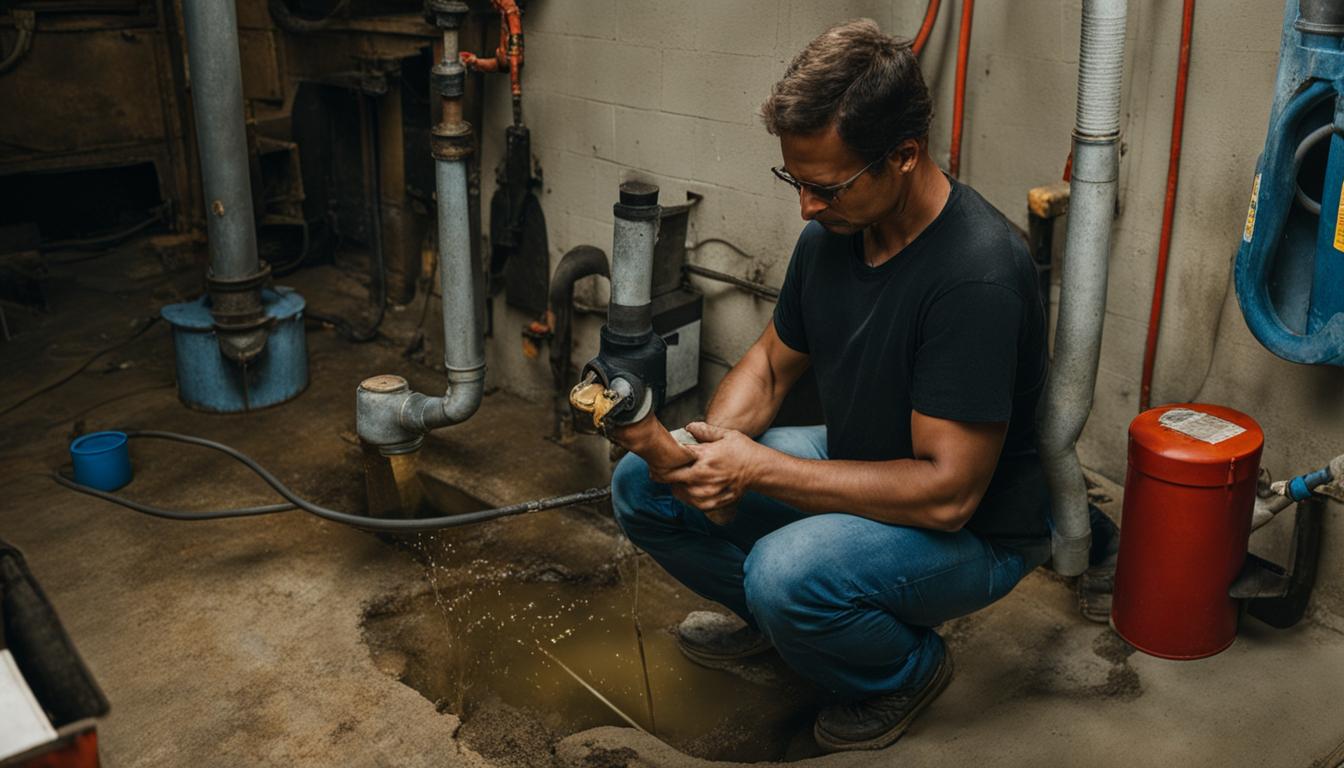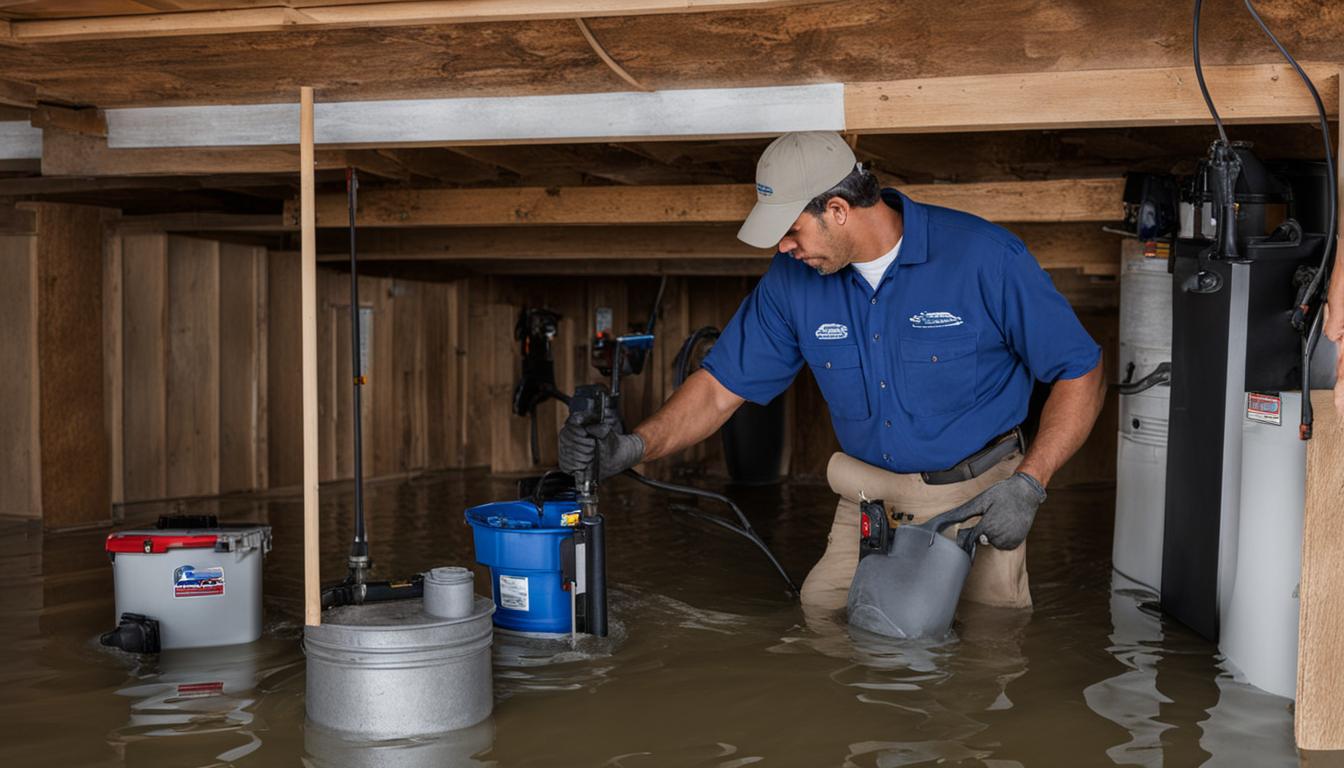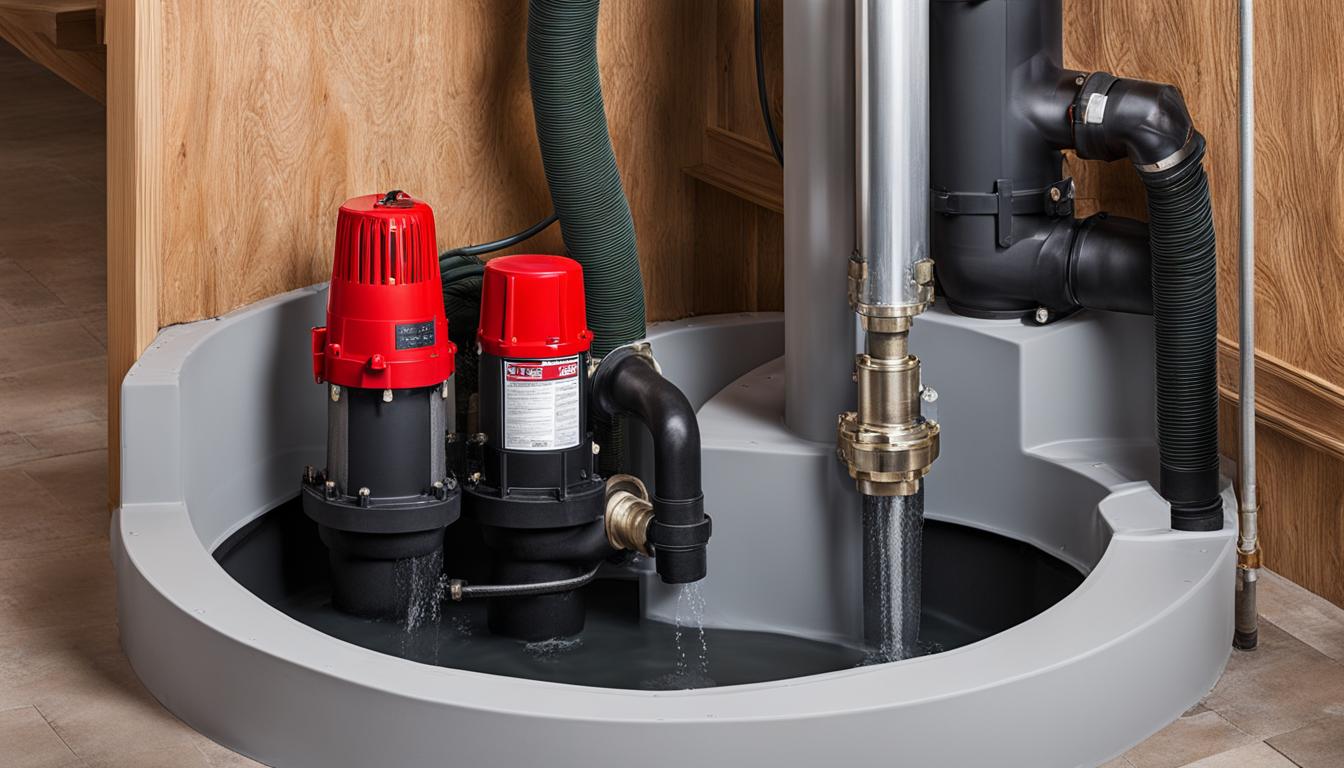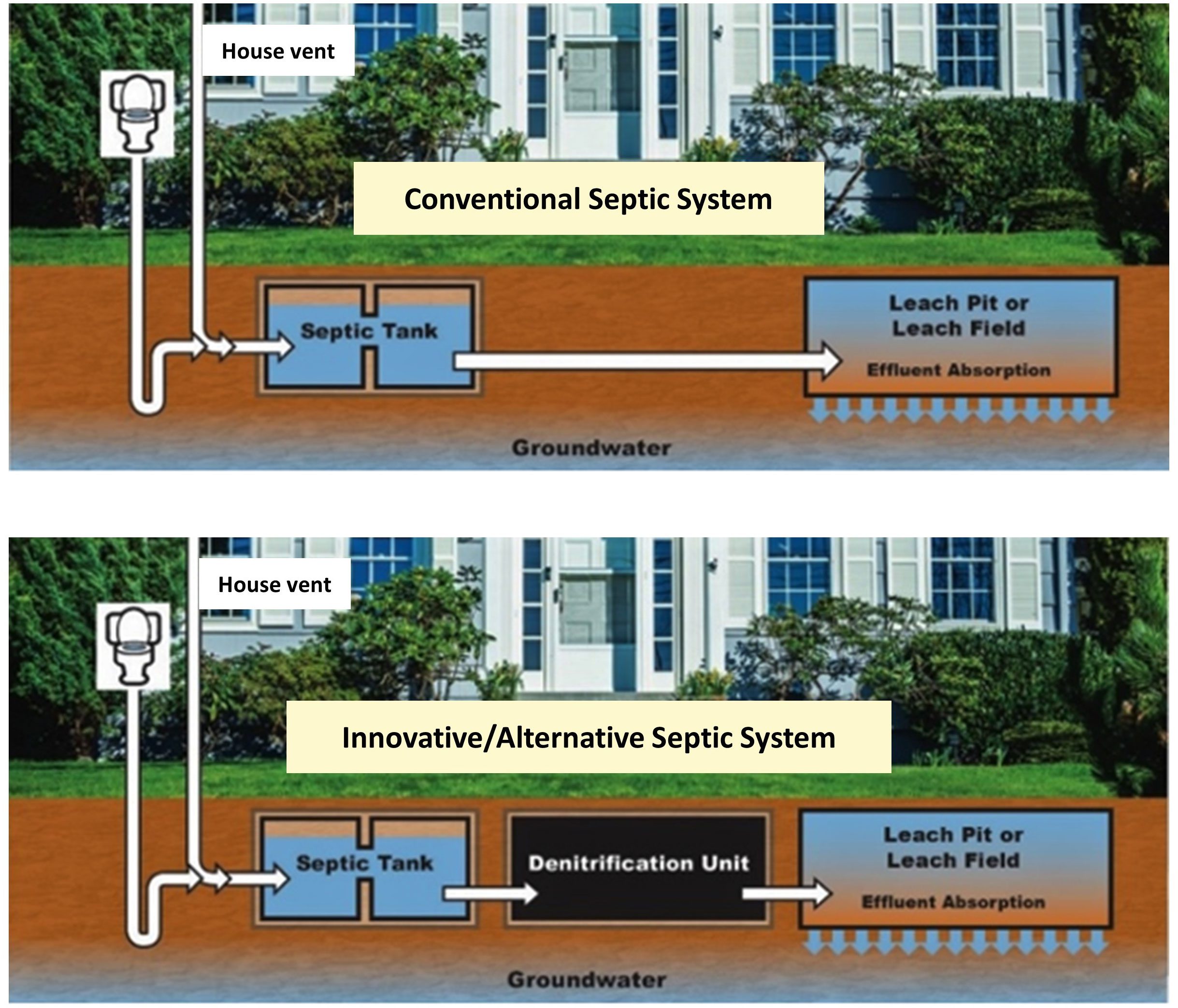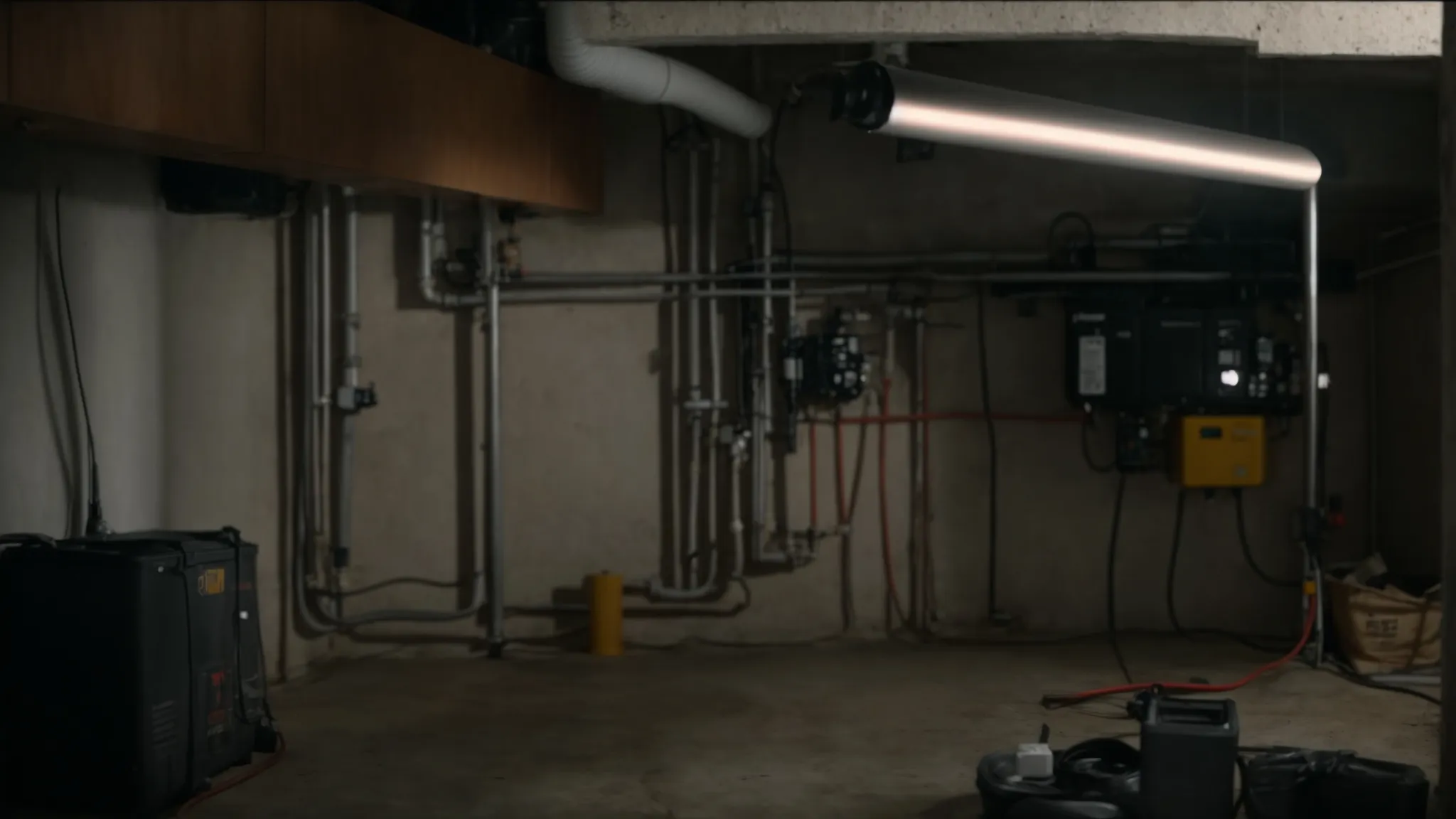As homeowners, we understand how important it is to protect our homes from potential damage. One common threat that many homeowners face is water damage caused by flooding or pump failure. This is where installing a backup sump pump comes in.
A backup sump pump is an additional pump installed in your basement, designed to kick in if the primary pump fails or in case of a power outage. It provides redundancy and added protection, keeping your basement dry and preventing potential water damage.
In this section, we will discuss the importance of installing a backup sump pump. We will also provide a comprehensive installation guide, including step-by-step instructions and tips to ensure a successful installation.
Key Takeaways
- A backup sump pump provides added protection and redundancy to your home’s sump pump system.
- Installing a backup sump pump can prevent potential water damage caused by flooding or primary pump failure.
- Our step-by-step installation guide includes everything you need to know to install a backup sump pump in your home.
- A dual pump setup can provide the highest level of protection for your basement.
- Regular maintenance and testing are crucial to ensure the proper functioning of your backup sump pump.
Understanding the Need for Backup Sump Pump Installation
At [Company Name], we believe in the importance of emergency preparedness, especially when it comes to protecting your home from potential water damage. This is why we highly recommend investing in a backup sump pump system.
Power outages are a common occurrence, and your primary sump pump relies on electricity. If a power outage occurs during a heavy rainstorm, your basement could quickly become flooded, causing significant damage to your home. Installing a backup sump pump with a battery system ensures that you have an effective power outage solution to protect your home.
In addition to power outages, primary sump pumps can fail due to mechanical issues or clogging from debris. A backup sump pump provides redundancy in case of primary pump failure, ensuring that there is always a back-up system in place to keep your basement dry.
“An ounce of prevention is worth a pound of cure.” – Benjamin Franklin
Investing in a backup sump pump system is an example of a preventative measure that can save you time and money in the long run.
Benefits of a Backup Sump Pump System
The benefits of having a backup sump pump system go beyond just preventing water damage. It can also:
- Provide peace of mind during heavy rainstorms and power outages
- Increase the value of your home
- Save money on potential repairs
Overall, a backup sump pump system is an essential component of home maintenance, helping to protect your home and belongings from potential water damage and providing a valuable emergency preparedness solution.
Choosing the Right Backup Sump Pump
When it comes to flood protection, selecting the right backup sump pump is crucial. There are several types available, including water-powered, battery-powered, and combination systems. To determine which one is the best fit for your needs, consider the following factors:
- Water backup needs: If your area is prone to heavy rainfall or your home is located near a body of water, a backup sump pump with a high water backup capacity is essential.
- Battery backup: If power outages are common in your area, consider a backup sump pump with a battery backup system. This will ensure your pump continues to function even during a power outage.
- Installation space: Depending on the size of your basement, you may need a compact backup sump pump system. Consider the available installation space before purchasing your backup sump pump.
A combination system, which includes both water and battery-powered backup options, can be an ideal solution for those seeking comprehensive flood protection. With a combination system, you’ll have the peace of mind in knowing that your home is protected from water damage, regardless of the situation.
Assessing Your Basement for Installation
Before beginning the installation of your backup sump pump, it’s crucial to assess your basement and determine the ideal location for it. This step ensures maximum safety enhancement and efficiency of your pump system in case of water emergencies.
Installation Steps
Follow the steps below to assess your basement for installation:
- Begin by inspecting your current sump pump location to ensure it’s placed in the lowest point of your basement floor.
- Check the area for any potential obstructions that may hinder the backup sump pump’s function, such as pipes, beams, or walls.
- Test the electrical outlets in the vicinity of the backup sump pump to ensure they are functioning correctly and make sure there is a nearby GFCI outlet to plug the pump into.
- Determine the battery backup system’s placement if applicable and consider installing a high-water alarm to detect high water levels in your basement.
- Create a diagram or blueprint of your sump pump system to help visualize the placement and identify any potential issues.
Safety Enhancement
Assessing your basement for installation not only ensures optimal functionality but also enhances safety measures in case of water emergencies. By placing the backup sump pump in the lowest point of your basement floor, you guarantee that water will not accumulate in other areas of your home. Additionally, testing the electrical outlets and installing a high-water alarm provide extra precautions to alert you of potential water damage and reduce the possibility of electrical hazards.
Gathering the Necessary Tools and Materials
Before we can begin the installation process, we need to ensure that we have all the necessary tools and materials. Here’s a list of everything you’ll need:
| Tools | Materials |
|---|---|
| Measuring tape | Backup sump pump |
| Hacksaw | Battery (if applicable) |
| PVC cutter | PVC pipe (1 1/2 inches or 2 inches in diameter) |
| Screwdriver | Check valve |
| Adjustable wrench | Plumbing cement |
| Drill | Concrete screws (if securing to floor) |
| Utility knife | Electrical tape |
Having all of these tools and materials at hand will streamline the installation process and ensure that everything runs smoothly according to the installation guide.
Preparing Your Basement for Installation
Before installing the backup sump pump, it’s essential to assess your basement and determine the optimal location for the pump. Proper preparation can ensure a smooth installation process and enhance the safety of your basement. Here are the steps you should take:
- Remove any obstructions: Clear the area around the primary sump pump and the backup location. Remove any clutter or debris that may be in the way of the installation.
- Check the discharge pipe: Ensure that the primary sump pump’s discharge pipe is not obstructed. The backup sump pump will be connected to the same pipe, so it’s essential to make sure it’s clear.
- Ensure adequate space: The backup sump pump should be installed at a higher elevation than the primary pump to prevent any backflow. Make sure that there is enough space for the backup pump and that it’s not too close to the primary pump.
- Install check valves: Check valves should be installed on both the primary and backup sump pumps’ discharge pipes to prevent water backflow. Make sure to install them correctly, following the manufacturer’s installation instructions.
- Connect the backup pump: Once you have assessed your basement and determined the optimal location for the backup pump, it’s time to connect it. Refer to the manufacturer’s installation guide for specific instructions on connecting your backup sump pump to the discharge pipe.
By following these steps, you can enhance the safety of your basement and ensure a smooth installation process for your backup sump pump.
Installing the Backup Sump Pump
Now that you have assessed your basement and gathered all the necessary tools and materials, it’s time to move on to the installation process. Follow these installation steps carefully to ensure proper setup and functionality of your backup sump pump.
Step 1: Connect the Pump to the Discharge Pipe
- Attach the check valve to the backup sump pump.
- Connect the discharge pipe to the check valve.
- Secure the pipe using pipe clamps or a mounting bracket.
Note: It’s essential to ensure the pipes slope away from the house to prevent water from flowing back into the basement.
Step 2: Install the Battery Backup System
If your backup sump pump comes with a battery backup system, follow these steps to install it:
- Connect the battery to the control unit as per the manufacturer’s instructions.
- Mount the control unit in a dry and easily accessible area.
- Connect the control unit to the backup sump pump.
- Plug the battery charger into a nearby outlet and ensure it’s charging the battery.
Note: It’s important to test the battery backup system to ensure it’s functioning correctly. You can do this by unplugging the primary pump or simulating a power outage to activate the backup pump.
Step 3: Set up the Dual Pump System (Optional)
If you’re installing a dual pump system, follow these steps to connect the two pumps:
- Attach the check valve to the primary sump pump.
- Connect the discharge pipe to the check valve.
- Attach a T-fitting to the pipe, and connect another pipe to the T-fitting.
- Attach the check valve to the backup sump pump.
- Connect the other end of the pipe from the T-fitting to the backup pump’s check valve.
- Secure the pipes using pipe clamps or a mounting bracket.
Step 4: Test the Backup Sump Pump
Once the installation is complete, test the backup sump pump to ensure it’s functioning correctly. You can do this by pouring water into the sump pit until the primary pump activates, and then unplugging the primary pump to activate the backup pump. Check the discharge pipe for water flow to ensure it’s working correctly.
Note: It’s essential to conduct routine tests to ensure the backup sump pump is always operational and ready to protect your home in case of emergencies.
Testing and Maintaining Your Backup Sump Pump
Once you’ve installed your backup sump pump, it’s essential to ensure that it’s functioning correctly. Performing routine tests and maintenance tasks can help prevent potential issues and ensure that your backup sump pump is ready to protect your home at all times.
Testing Your Backup Sump Pump
It’s recommended to test your backup sump pump at least once a year, ideally before the rainy season or any severe weather. To test your backup sump pump, follow these steps:
- Locate the float switch on the backup pump and lift it to activate the pump.
- Verify that the backup pump is running correctly, and water is flowing out of the discharge pipe.
- Turn off the backup pump and let the float switch drop to its original position.
- Test your primary sump pump by unplugging it or manually turning off its power source.
- Observe the backup sump pump’s operation and ensure it activates when the water level rises.
If your backup sump pump fails any of these tests, it’s essential to address the issue immediately. Refer to the troubleshooting section below for further guidance on how to tackle any problems.
Maintaining Your Backup Sump Pump
Regular maintenance can significantly extend the life of your backup sump pump and ensure that it’s always in optimal condition.
Here are some maintenance tasks you should perform:
- Check the backup pump’s power source, ensuring that it’s connected to a functional battery or alternative power source.
- Clean and inspect the pump and discharge pipe for any debris or clogs.
- Remove and clean the pump’s intake screen if applicable.
- Check for any signs of wear on the backup pump, such as cracks or leaks, and replace any damaged parts.
Troubleshooting Common Issues
Despite regular testing and maintenance, backup sump pumps can sometimes encounter issues. Here are some common problems you may encounter and how to troubleshoot them:
Problem: Backup pump doesn’t turn on during a power outage.
Solution: Check the battery or other power source to ensure it’s connected and functioning correctly. Consider upgrading to a higher capacity battery or alternative power source for longer-lasting backup power.
Problem: Backup pump runs continuously.
Solution: Check for any debris or clogs in the discharge pipe or pump. Make sure the float switch is set at the correct level and adjust it as necessary. If the problem persists, consider contacting a professional for further assistance.
Remember, if you’re unsure how to troubleshoot any issues with your backup sump pump, reach out to a professional for assistance. Regular maintenance and testing can help prevent potential problems, ensuring that your backup sump pump is always ready to protect your home.
Troubleshooting Common Issues
Even with proper installation and maintenance, backup sump pumps can experience problems. Here are some common issues you might encounter and how to address them:
Problem: Backup Sump Pump Won’t Turn On
If the backup sump pump won’t turn on during a power outage or when the primary pump fails, there may be an issue with the battery backup system. Check the battery connections and make sure they are secure. If the connections are loose, tighten them and try again.
If the connections are secure but the backup pump still won’t turn on, the battery may need to be replaced.
Problem: Backup Pump is Running Continuously
If the backup sump pump is running continuously, it could indicate that the primary pump is not working correctly, and water levels are rising too high. Inspect the primary pump for any issues, such as a clogged intake or a faulty switch. If the primary pump is not working correctly, the backup pump will continue to run.
Problem: Strange Noises Coming from the Backup Pump
If you hear unusual noises coming from the backup sump pump, such as grinding or whirring, turn off the pump immediately. Unusual noises can indicate a mechanical problem that may cause the pump to fail. Inspect the pump for any visible damage or wear and call a professional if necessary.
Problem: Battery Backup System is Beeping
If the battery backup system is beeping, it could indicate that the battery is low and needs to be recharged or replaced. Check the battery backup system’s user manual for specific instructions on how to address the beeping sound.
Regularly testing and inspecting your backup sump pump system can help you catch issues before they become major problems. If you encounter any issues with your backup sump pump system that cannot be resolved by basic troubleshooting, consider calling a professional for assistance.
Enhancing Your Backup Sump Pump System
Aside from the primary and backup sump pumps, there are additional components that can help enhance the effectiveness of your system. Here are some options to consider:
Battery Backup System
A battery backup system ensures that your backup sump pump will continue to function during power outages. It’s essential to choose the right backup battery for your system, so make sure to consult with a professional or your sump pump’s manufacturer before purchasing.
High-Water Alarm
A high-water alarm alerts you when the water level in your sump pump pit rises above a certain level. This will give you an early warning that your primary or backup sump pump is not working correctly or that there is a severe flooding issue. A high-water alarm is an essential component to consider when enhancing your backup sump pump system.
Water-Powered Backup Pump
A water-powered backup pump is an excellent option if you want an additional layer of protection. It works by using water under pressure to create a vacuum that draws water out of the sump pit. This type of pump does not require electricity, making it a great option during power outages.
Remember that these components are not substitutes for regular maintenance and inspection. Regular maintenance will ensure that your system is functioning correctly and can help prevent unnecessary wear and tear.
Regular Maintenance and Inspection
Regular maintenance and inspection are critical to extending the lifespan of your backup sump pump and ensuring its functionality. We recommend performing routine checks on your backup sump pump system every six months. Additionally, it’s essential to test the system’s battery backup power at least once every three months or more frequently, depending on your specific needs.
During routine checks, you should inspect the backup sump pump and its components for any signs of wear and tear or damage. Check the power cord for any cracks or fraying and ensure that the pump inlet and outlet are free of debris or obstructions. If you have a battery backup system, make sure the battery’s terminals are clean and free of corrosion.
Example Maintenance and Inspection Checklist
| Task | Frequency | Notes |
|---|---|---|
| Check the backup sump pump for proper operation | Every 6 months | Test the float switch and listen for any unusual noises or vibrations from the pump. |
| Inspect the power cord and electrical connections | Every 6 months | Check for any fraying or cracks in the cord and confirm that all connections are tight and secure. |
| Test the battery backup system | Every 3 months | Ensure that the battery is fully charged and test the system by unplugging the primary pump and monitoring the backup pump’s performance for at least 15 minutes. |
| Clear sump basin of debris and sediment | Every 6 months | Clean the sump basin by removing sediment, debris, or any other materials that may interfere with the pump’s function. |
By following this maintenance and inspection checklist, you can keep your backup sump pump system in top condition and rest assured that it will work as intended during emergency situations.
Conclusion
In conclusion, we hope this installation guide has been informative and helpful in guiding you through the process of installing a backup sump pump. It’s essential to take the necessary steps to protect your home from potential water damage and ensure an emergency preparedness plan is in place.
Remember to choose the right backup sump pump for your needs, assess your basement for installation, gather the necessary tools and materials, and prepare the area before installation. Follow the step-by-step guide outlined in this article, testing and maintaining your backup sump pump regularly to ensure it remains in optimal condition.
In the event of any issues, refer to our troubleshooting tips and consider enhancing your backup sump pump system with additional components such as high-water alarms or water-powered backup pumps.
Overall, with a little effort and investment in installation, a backup sump pump can provide peace of mind and protection for your home. We encourage you to take the necessary steps to ensure your home is safe and dry even during power outages or primary pump failures.
Thank you for reading our installation guide and taking the first step towards a safer and more secure home environment.
FAQ
Why is installing a backup sump pump important?
Installing a backup sump pump is crucial because it provides an extra layer of protection against potential water damage in your home. In case of a power outage or primary pump failure, the backup sump pump will continue to pump water out of your basement, preventing flooding and costly repairs.
What are the benefits of backup sump pump installation?
Backup sump pump installation offers several benefits. It ensures that your basement stays dry even during power outages, reduces the risk of water damage, and provides redundancy in case the primary pump malfunctions. It offers peace of mind and protects your property from flooding.
How do I choose the right backup sump pump?
Selecting the right backup sump pump depends on your specific needs. Consider factors such as water backup requirements, flood protection needs, and system compatibility. It’s advisable to consult with a professional to determine the most suitable backup sump pump for your home.
How should I assess my basement for installation?
Assessing your basement is essential before installing a backup sump pump. Evaluate the location where the pump will be installed, ensuring it is near a power source and discharge pipe. Take measurements, identify any potential obstacles, and make sure the area is clear and ready for installation.
What tools and materials do I need for installation?
To install a backup sump pump, you will need tools such as a utility knife, pipe wrench, screwdriver, and pliers. The necessary materials include PVC pipe, check valve, couplings, and discharge hose. It’s important to gather all the required tools and materials before starting the installation process.
How do I prepare my basement for installation?
Properly preparing your basement is crucial for a successful installation. Clear the area of any debris or obstructions, remove water if present, and ensure the floor is dry. Create a suitable setup for the backup sump pump by securing the discharge pipe and establishing a connection to a power source.
What are the installation steps for a backup sump pump?
Installing a backup sump pump involves several steps. First, connect the pump to the discharge pipe, ensuring a watertight seal. Then, install the check valve and secure the system to a power source. If applicable, set up the battery backup system. Test the pump for proper functionality before completion.
How do I test and maintain my backup sump pump?
Testing and maintaining your backup sump pump is essential for its optimal performance. Perform regular tests to ensure the pump activates correctly and pumps water out of your basement. Additionally, conduct routine maintenance tasks such as cleaning the pump, inspecting the battery, and checking for any signs of wear or damage.
What are common issues with backup sump pumps, and how can I troubleshoot them?
Common issues with backup sump pumps may include power failures, clogged floats or switches, or malfunctioning batteries. To troubleshoot, check the power source, clean any debris obstructing the float or switch, and ensure the battery is in good condition. If the problem persists, it’s advisable to consult with a professional for further assistance.
Are there additional components to enhance a backup sump pump system?
Yes, there are additional components that can enhance a backup sump pump system. Consider installing high-water alarms to alert you of rising water levels and water-powered backup pumps that operate without electricity. These components add an extra layer of safety and further protect your home from potential flooding.
How often should I inspect and maintain my backup sump pump?
It’s recommended to inspect and maintain your backup sump pump on a regular basis. Check the pump and its components at least twice a year, typically during spring and fall. Perform routine maintenance tasks such as cleaning, testing, and battery checks to ensure your backup sump pump remains in optimal working condition.
